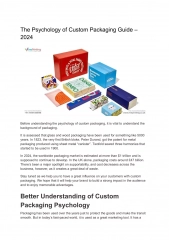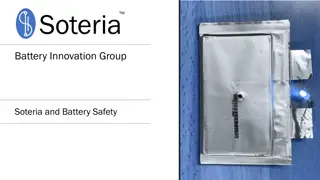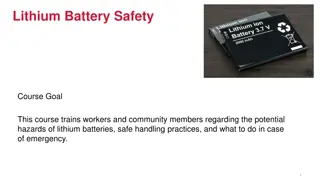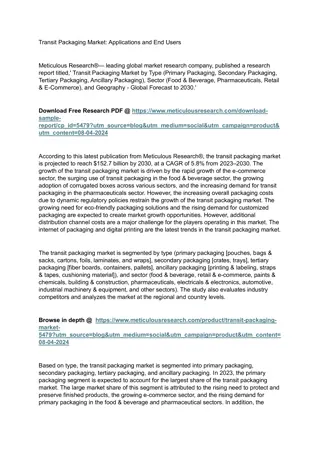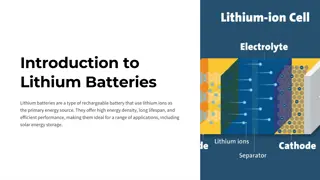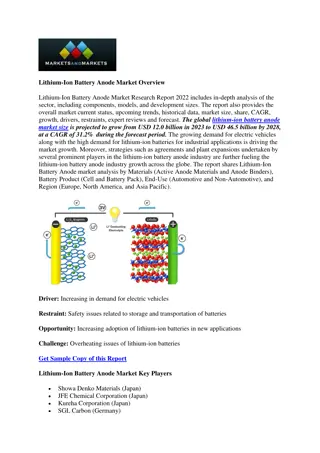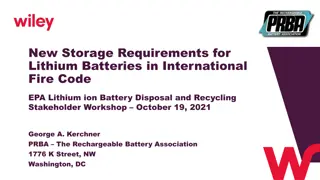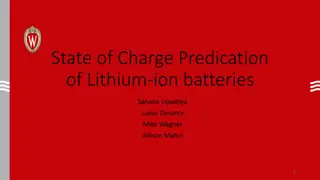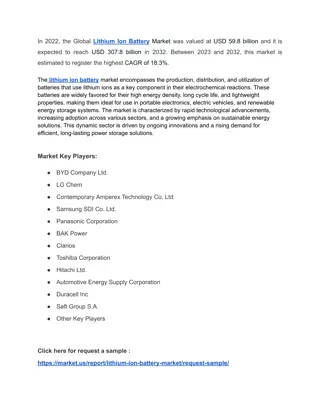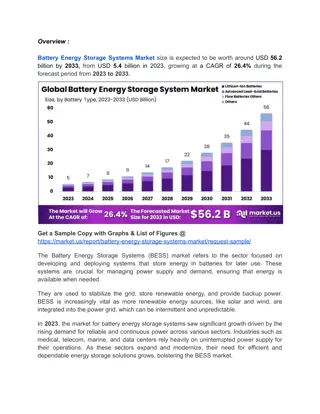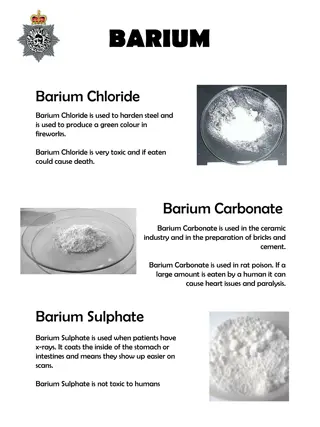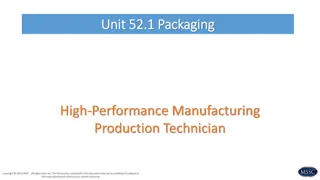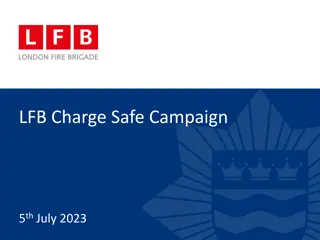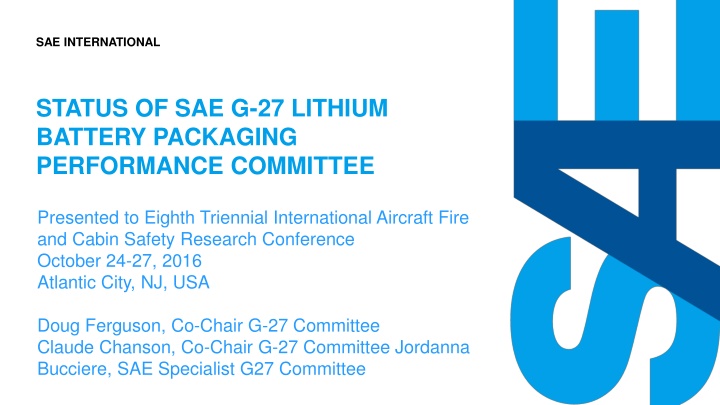
SAE G-27 Lithium Battery Packaging Standard
This document provides an overview of the SAE G-27 Committee and its role in developing performance standards for the safe shipment of lithium batteries as cargo on aircraft. The committee's charter, objectives, and collaboration with aviation industry bodies are highlighted, emphasizing the importance of ensuring battery safety during transportation.
Download Presentation

Please find below an Image/Link to download the presentation.
The content on the website is provided AS IS for your information and personal use only. It may not be sold, licensed, or shared on other websites without obtaining consent from the author. If you encounter any issues during the download, it is possible that the publisher has removed the file from their server.
You are allowed to download the files provided on this website for personal or commercial use, subject to the condition that they are used lawfully. All files are the property of their respective owners.
The content on the website is provided AS IS for your information and personal use only. It may not be sold, licensed, or shared on other websites without obtaining consent from the author.
E N D
Presentation Transcript
SAE INTERNATIONAL STATUS OF SAE G-27 LITHIUM BATTERY PACKAGING PERFORMANCE COMMITTEE DRAFT Presented to Eighth Triennial International Aircraft Fire and Cabin Safety Research Conference October 24-27, 2016 Atlantic City, NJ, USA Doug Ferguson, Co-Chair G-27 Committee Claude Chanson, Co-Chair G-27 Committee Jordanna Bucciere, SAE Specialist G27 Committee
SAE G27 Committee Why is committee formed and why a packaging standard? The Council of the International Civil Aviation Organization (ICAO) established a prohibition on the transport of lithium batteries as cargo on passenger aircraft as a temporary measure until controls were put into place which establish an acceptable level of safety. A performance-based packaging standard was identified as one of the controls. SAE International chosen to lead this effort through creation of an SAE Aerospace standard. Performance based package standard for lithium batteries as cargo on aircraft (AS6413) This SAE Aerospace Standard (AS) specifies a minimum performance package standard that supports the safe shipment of lithium batteries as cargo on aircraft. SAE INTERNATIONAL SAE INTERNATIONAL OVERVIEW-EUROPE OFFICE 2
SAE G27 Committee Charter SAE G-27, Lithium Battery Packaging, is a technical committee in SAE s General Projects Systems Group with the responsibility for the development and maintenance of minimum performance package standards that support the safe shipment of lithium batteries as cargo on aircraft. The committee works in conjunction with related bodies such as the International Civil Aviation Organization (ICAO), International Air Transport Association (IATA), International Federation of Airline Pilots Association (IFALPA), International Coordination Council for Aerospace Industry Association (ICCAIA), European Association for Advanced Rechargeable Batteries (RECHARGE), Rechargeable Battery Association (PRBA), Battery Association of Japan (BAJ), defense agencies, and regulatory authorities. The committee was established at the request of ICAO to develop a package performance standard for lithium batteries and packaging based on the high-level performance standards developed during the third Multidisciplinary Lithium Battery Transport Coordination Meeting. SAE INTERNATIONAL 3
SAE G27 Committee Charter The objectives of the G-27 Committee are to: Develop Aerospace Standards (AS) for a minimum performance standard to safely ship lithium batteries as cargo on aircraft. The standard may include packaging design, qualification, test procedures and any other related tasks. Provide a forum for the exchange of technical information related to lithium battery packaging for transportation by air. SAE INTERNATIONAL 4
AS 6413 Development and Writing Team Standards Development Process Writing Team developed draft for standard (~20 people) Draft standard circulated to entire G-27 committee (over 160 people) for review and comments (iterative process to incorporate comments) Balloting process involves all stakeholders with opportunity to comment on proposed standard: Ballot disapprovals must be resolved between the commentor and document sponsor. Comments from non-voting members must be reviewed and considered. Voting members (~50) are being identified SAE INTERNATIONAL 5
Optimistic AS 6413 Projected Timeline (As of October, 2016) 2016 2017 1) Feb 2) Mar 3) May 4) 5) Nov 6) and 8) Jan 7) Mar 9) and 10) Apr 11) May June 1) Initial G-27 meeting 2) Document Development (face to face followed by virtual - ongoing) 3) Document Review (face to face and virtual - ongoing) 4) Development Testing 5) Document finalization (~ 4 weeks from final comments) 6) Committee Balloting (28 days) 7) Resolve Disapprovals (~3 weeks) 8) Validation Testing (continues until end of affirmation balloting) 9) Affirmation Balloting (14 days) 10) Council Balloting (28 days) 11) Publication SAE INTERNATIONAL
AS 6413 Development and Writing Team Standards Development Process One telephone conference of full G27 committee per month since February Draft standard writing team of ~20 people have met multiple times starting with a 1 week face-to-face in March. Face to face meeting of G-27 committee May 19-20 in Toulouse, France 3rd Preliminary draft of AS6413 on SAE G-27 website for comments Next G-27 face to face meeting November 17-18 in Huntington Beach, CA, USA. SAE INTERNATIONAL 7
AS 6413 Development and Writing Team Writing Team Approximately 20 individuals with standards and test experience balanced with geographic representation from the following stakeholders: Aircraft cargo fire protection specialists Regulatory authorities Operators Pilots Packaging manufacturers Battery manufacturers Test houses SAE INTERNATIONAL 8
AS 6413 Draft Content This standard provides a test method to demonstrate and document the control of the potential hazards from Lithium metal batteries (UN 3090) and Lithium ion batteries (UN 3480) when transported as cargo on aircraft. It addresses the need to control the hazards which might arise from a failure of an individual cell by containing the hazards within the package. Controlling the consequences of a failure within the package is intended to prevent uncontrolled fire and pressure pulses that may compromise current fire suppression systems within the cargo compartment. The intent of this test is to severely abuse a single cell such that it is most likely to enter thermal runaway with the presumption that a single cell may enter thermal runaway during transport. SAE INTERNATIONAL 9
AS 6413 Draft Content The package will be placed in a transparent box with a [0.3] m3 free volume that will contain gases generated from Thermal Runaway (TR). The box will have a rapid overpressure opening that will be sealed with a rupture foil. A spark ignition source will be energized continuously within the box volume, capable of igniting vapors reaching a flammable concentration within the box. Rationale for volume size is explained within draft standard SAE INTERNATIONAL 10
AS 6413 Draft Content For testing individual cells, Use a heat source (e.g. tape, cartridge) to create a temperature rise at 5 to 10 C (9 to 18 F) per minute as measured at an external point on the cell that is most representative of the cells internal temperature. SAE INTERNATIONAL 11
AS 6413 Draft Content If there is clear external evidence of cell thermal runaway, power to the heat source will be stopped. If clear evidence of cell thermal runaway has not occurred, monitor the cell temperature as measured at an external point on the cell that is most representative of the cells internal temperature and hold at 200 C (392 F) for 1 hour then remove power to the heat source. The unit under test will be monitored for 5 hours after removal of power to the heat source. Test to be run until failure occurs or for 6 hours minimum in case no failure is observed. For testing batteries, the goal is to use the same methodology applied to a single cell within the battery, but there may be more than one single method for triggering TR, depending on the battery type and construction. SAE INTERNATIONAL 12
AS 6413 Draft Content The pass test criteria shall include evidence of: Non-hazardous flame: (A flame exiting the package under test that does not contain sufficient energy to ignite adjacent packages.) No flame A flame of short duration (less than 0.2 seconds), a short length [less than 5 cm] and a small rate of occurrence [<3 times total] during the test Non-hazardous Fragment: (A fragment that has exited the package with insufficient energy to pass through or ignite adjacent packaging.) No visible fragments exiting the package (smoke particles are not considered fragments) At the end of test, the outer package shall be examined and the outside packaging shall not have any penetrations (no fragments may exit any vent mechanisms). Non-hazardous Surface temperature: Temperature measured at center of each package surface will not exceed a peak maximum temperature of 200 C for [3] minutes with a tbd minute integrated average not to exceed 150 C. Non-Hazardous Quantity of Flammable Vapor: There shall be no evidence of flame other than allowed per non-hazardous flame. SAE INTERNATIONAL 13
G27 Open Issues A subcommittee is being formed to address the potential hazards of lithium batteries packaged as required by the Dangerous Goods Technical Instructions in the event of a cargo fire due to some external event. What would be the rationale for including this scenario? What are the conditions that may be representative of an external fire event? What is an appropriate location for identification and/or test of possible mitigation means in the packaging standard, in guidance to be used with the packaging standard, or in a different document? A section of the document is intended to address an appropriate analytical method to use test data involving specific cells and specific minimal packaging as the basis for not repeating the testing for similar configurations (e.g. same cell part number and characteristics, but fewer cells, etc). Wording is being proposed and will be discussed. Acceptability of sub assembly test for large format batteries. Possibility to test cells and batteries with no or benign hazards in case of thermal run-away, allowing for transport in any case of package. It is anticipated that these open issues will need to be addressed prior to final approval of the packaging standard. SAE INTERNATIONAL 14
QUESTIONS? Doug Ferguson Boeing Associate Technical Fellow SAE G-27 Co-Chair o +1 562.593.2950 douglas.e.ferguson@boeing.com Jordanna Bucciere Aerospace Standards Specialist SAE International Claude Chanson General Manager - RECHARGE SAE G-27 Co-Chair o +1.724.772.7517 m +1.724.612.5339 Jordanna.lehman@sae.org o +32 (2)777-0567 cchanson@rechargebatteries.org SAE INTERNATIONAL 15



